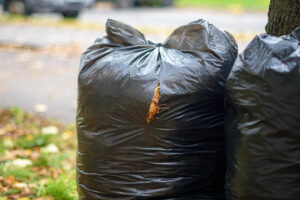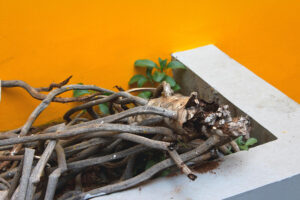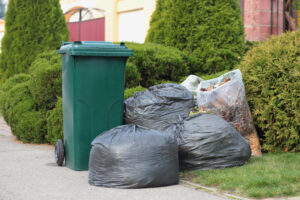You wouldn’t think the spot where you place your garden bag could cause issues, but it definitely can. Bad placement can slow down or even stop collection altogether. Whether it’s blocked by a car, sitting uneven on a slope, or tucked away behind some bushes, these things make it harder for crews to get the job done properly.
Good placement, on the other hand, saves a lot of time and stress. When your garden bag is easy to access, your green waste gets picked up on time without hassle. Plus, it keeps your space tidy and avoids any unnecessary do-overs. If you’re using a 600-litre bag, which can get heavy quick, keeping it in the right spot makes a big difference.
Choosing The Best Location For Your Garden Bag
Figuring out where to put your garden bag shouldn’t be a last-minute job. A little bit of thought now will save you plenty of frustration later. To get things off to a smooth start, set it up in a place that ticks a few simple boxes.
Here’s what to look for when choosing the right spot:
– A flat and stable surface – gravel, concrete, or firm grass works best. If it leans or tilts, the bag can fall, making it hard to fill or empty.
– Accessible ground level – avoid raised decks, steps, or steep driveways. Crews can’t move garden bags up or down these safely.
– No tight corners – make sure there’s room to move around the bag without bumping into fences, garden beds or equipment.
– Shade isn’t everything – while it might seem like a good move to pop your garden bag under a tree, falling leaves can fill it too quickly and overhanging branches might get in the way during pickup.
If you’re unsure, think about how someone else, who doesn’t know your layout, could reach it. An example would be placing the bag on the flat ground near your driveway but not directly in it. That way, it’s easy to get to and still leaves space for your vehicle.
And remember, once set up, the spot should stay the same. Moving the bag around creates confusion and delays. Once the metal frame is installed securely, it’s best to stick with it.
Ensuring Easy Access For Collection Crews
Your garden might suit you perfectly, but if crews can’t get to the bag, green waste won’t get picked up. Collection teams need a clear, safe path. That doesn’t just help them do their job faster; it keeps everyone safe, including you.
Think about anything that might block the way, like:
– Overgrown branches brushing against walkways
– Bins, toys, or bikes left near the setup
– Vehicles parked too close on pickup day
– Pets that might be loose or fences that get stuck
In many cases, it’s the small things that cause big problems. Even something like gravel getting loose on a path can be enough to make moving the bag harder.
Here’s a handy list to help keep the space crew-friendly:
1. Keep the area near the bag free of clutter at all times.
2. Trim any shrubs or plants hanging over the route.
3. Keep the gate unlocked or any entry points open on collection day.
4. Avoid parking vehicles right in front of the setup spot.
5. Double-check the bag is standing upright and ready to go by 7am.
If the bag’s hard to reach or surrounded by stuff, there’s a good chance the team won’t be able to collect your green waste on that run. Keeping access clear means things won’t fall behind or get missed, and your outdoor space stays clean without extra effort.
Tips For Preventing Overloading And Spillage
A neatly packed garden bag isn’t just easier to collect. It also avoids spills, mess, and follow-up clean ups. Overloading happens quickly, especially during spring when pruning, mowing and weeding ramp up. If the garden waste sits above the top of the metal frame, it slows down collection and can even cause the whole bag to be left behind. That’s something no one wants.
It’s a good idea to keep an eye on how quickly your bag is filling up. Instead of cramming it full, plan ahead and keep it level with the top of the frame. Cramming bits of hedge trimmings or piling grass clippings too high may save one trip, but it usually creates more trouble than it’s worth.
Here’s what to check before collection day:
– The contents are kept level, nothing sticking up past the top rail of the frame.
– The bag isn’t leaning to one side or stretched out too far.
– The string lock is used correctly. Don’t tie it closed, just slip the lock into place so the top can be opened for easy emptying.
– There’s no general waste mixed in. Things like food scraps, pet litter, flax, or soil can’t go in. Stick with leaves, branches, grass, and weeds.
One helpful approach is to do a quick visual check every few days during active gardening weeks. If it looks like it’ll be full well before pick-up, avoid stuffing more into it. Either wait till after it’s emptied or set green waste aside for your next load. Smarter loading means smoother collection.
Practical Placement Examples And Year-Round Best Practices
The best spot for a garden bag isn’t always the most obvious one. That’s why thinking about your layout and usage habits can make a big difference. If your yard is large, placing the bag near the area where most of the green waste builds up, like close to your veggie garden or hedge line, saves time and effort. But it still needs to be on flat, stable and accessible ground.
Let’s say your section is sloped, or your main garden area is up some steps. Instead of placing the bag at the top near the gardens, keep it near ground level beside your driveway or at the kerb. It’s a shorter walk with your green waste in a wheelbarrow or sack than missing a whole pick-up.
To keep the spot neat and ready all year round:
– Give the surrounding area a quick tidy the day before pickup.
– Refresh gravel or mowing strips around the stand to prevent weeds or loose stones.
– Prune nearby trees or shrubs that might overhang or block the view of the bag.
– If you’ve got more than one outdoor service (like bins or compost bins), keep them spaced out to avoid bottlenecks for the crew.
Even during the wetter spring season, try to keep the base of your garden bag from sitting in wet patches or puddles. A soggy base can make the bag harder to manage and, over time, damage the structure of the surrounding lawn or pad. Laying timber planks, leftover pavers or a small concrete pad can help prevent this.
Keeping Your Auckland Garden Tidy And Accessible
Good garden bag placement sets everything else up to work smoothly. It means your green waste gets picked up when expected, your outdoor space stays organised, and you avoid frustrating delays from one simple decision.
Whether you’re looking ahead to spring clean-ups or just want to keep your outdoor area low-stress, taking time to get the placement right pays off. With the weather warming up in Auckland, now’s the perfect time to double-check that your garden bag is where it needs to be. Clear paths, solid ground and level packing does the trick.
A tidy garden isn’t just about what you see. It’s about how everything works together behind the scenes. When collection crews can get in and out easily, your green waste is gone quickly and without stress. Keeping that garden bag in the right place goes a long way towards making that happen every single time.
If you’re looking for a smarter way to handle your garden waste, take a look at how our garden bags can make things easier. At Green Collect, we set everything up for you and keep collections simple and reliable across Auckland.







